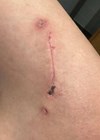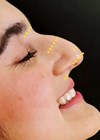A simple and reliable technique for post mastectomy nipple reconstruction.
The final stage of postmastectomy breast reconstruction is the recreation of the nipple areolar complex. This can only be considered when the breast shape has stabilised in terms of ptosis. Once the timing of the reconstruction is appropriate, there are two challenges:
- Recreating an areola, and
- The formation of a nipple.
Traditionally, the areola used to be formed using pigmented skin grafts from the upper inner thigh or even labia. My preference however is areola tattooing. This is an outpatient procedure performed by trained medical technicians.
With regard to the nipple itself, I have used many methods and have seen many problems with regards to loss of projection of the nipple and necrosis of grafts. A common outcome when using local flaps for nipple reconstruction is maintaining projection. I have tried incorporating free cartilage grafts, hyaluronic acid fillers and even buried integra (minus the silicone sheet), but without great success, especially where the skin is thin. Nipple sharing is not always feasible although it is a good option when available.
My best results
The most successful outcomes I obtained in my reconstructive practice were from using composite skin and tragal cartilage grafts. This is an easy procedure involving raising a superiorly based semi-circular skin paddle on the pre-marked tattooed areola on the breast mound, and then folding it upon itself to expose a vascularised bed that will accommodate a measured composite graft from the tragal area.
The tragal cartilage has an ideal three-dimensional shape and when naturally prominent gives a nice shape for nipple projection. It can be easily harvested and attached to a suitably sized ellipse of pre- and peri-tragal skin. The wound is closed directly and with imagination, remaining local cartilage can be used to give some tragal shape back. The donor scar should be virtually invisible, as in facelift.




Figures 1–4: These show the resultant deformity from extended simple mastectomy and no radiotherapy. The mound has been created using a sized anatomical shaped implant. The nipple reconstruction has already started with the positioning of areola tattoo determined by the specialist practitioner. A composite graft has been raised from the tragal area and inserted into the raw bed created by elevating a semi-circular superiorly based areola skin flap. The scar fits into the ‘cosmetic’ unit of the nipple.

Figure 5: Longer term result of nipple reconstruction using the same procedure in a second patient.
The composite ellipse is than sutured into the bed created by elevating the small flap in the areola with the cartilage itself, sutured with 5/0 vicryl rapide into the bed for fixation. The skin is closed with 5/0 vicryl rapide – a non-adherent doughnut cut gauze covers a small inadine dressing that has a small, central elliptical flap made to accommodate the nipple without squashing it under pressure. An overlying waterproof dressing covers the whole for two weeks. The results are as shown in Figures 1–5. Needless to say, the patients were delighted.
Declaration of competing interests: None declared.









